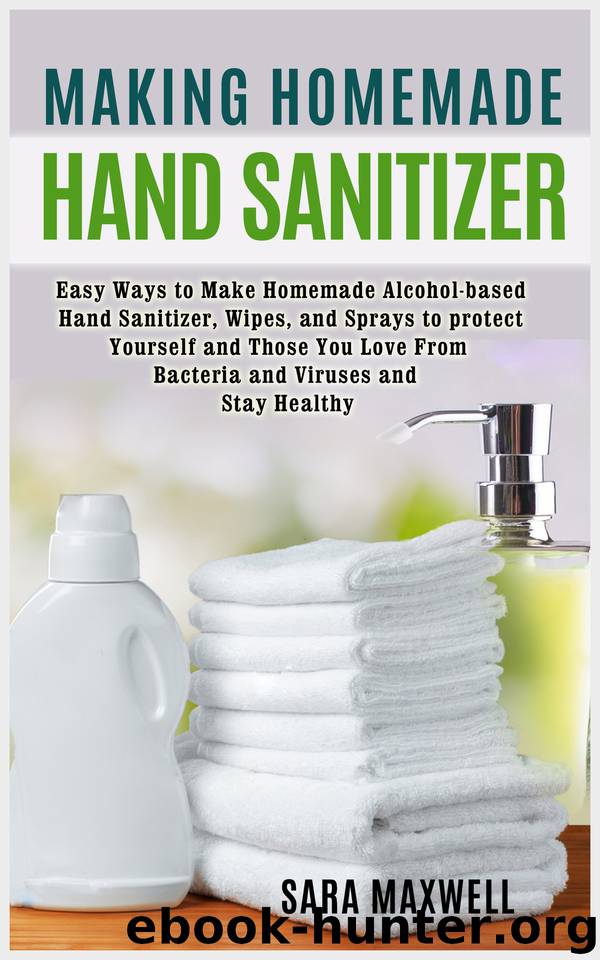Making Homemade Hand Sanitizer: Easy Ways to Make Homemade Alcohol-based Hand Sanitizer, Wipes, and Sprays to protect Yourself and Those You Love From Bacteria and Viruses and Stay Healthy. by Maxwell Sara

Author:Maxwell, Sara [Maxwell, Sara]
Language: eng
Format: epub
Published: 2020-03-27T16:00:00+00:00
Alcohol-based products contain one of two active ingredients: alcohol or isopropanol. Both are effective preservative products that kill bacteria and bacteria. They share many of the same features. Their main difference is at the molecular level. A unique feature common to all of them is that they are highly flammable. The FDA recommends that hand sanitizers contain 60-95% alcohol for maximum effectiveness. This high level of concentration has long raised concerns in both the media and healthcare. Hospitals and other facilities should contact the local fire department when planning to install an alcohol-based dispenser. Facilities must comply with local regulations and regulations when handling such flammable connections.
Another problem with alcohol-based hand sanitizers is the potential toxicity risk if swallowed. Most hand sanitizer dispensing mechanisms are easily opened. It will be placed in an accessible location to encourage use. Use caution when children and chemicals are in the same environment. Due to high alcohol concentrations, consumption by children and adults can lead to acute alcoholism.
A common side effect often associated with repeated use of alcohol-based hand sanitizers is dryness and cracks that can cause them in the hands. This is because alcohol removes oils from the skin that stores moisture. A temporary shortage of these oils may increase hand irritation to the surface. It can even cause dermatitis symptoms. Another complaint is that the alcohol in these products damages’ floors and walls. Alcohol can contaminate areas where donors may drip or leak.
Alcohol-based products are the method (handwashing) recommended by major global health organizations such as CDC, WHO, and FDA. It is still the most commonly used disinfectant in hospitals and other medical facilities. Its effects have been proven over and over again.
ALCOHOL-FREE HAND SANITIZERS
Some organizations, such as B. Schools are concerned about the supply of alcohol-based products. Alcohol-free disinfectants are now available. These active ingredients are benzalkonium chloride, which has traditionally been used as a topical wound disinfectant. California researchers have tested the effectiveness of nonalcoholic disinfectants compared to elementary school handwashing and have found a significant reduction in children's illness.
The Pros and Cons of Alcohol-Free Hand Sanitizers:
Most non-alcoholic products available today are available in aqueous foam. The product contains the active ingredients benzalkonium chloride and quaternary ammonium. In contrast to alcohol-based products, alcohol-free hand sanitizers often contain less than 0.1% benzalkonium. They nevertheless implement the equivalent level of assurance. The rest of the solution is mainly composed of water and is often rich in skin care products such as vitamin E and green tea extract. It is non-flammable and relatively non-toxic due to its low benzalkonium concentration. However, all of these products are recommended for external use only.
Alcohol-free hand sanitizers have entered the market, addressing gel concerns and complaints. In many ways, they did it. In principle, these solutions are much easier for hands. Even if alcohol is accidentally ingested, the threat is much smaller, and alcohol-free hand sanitizers have a lower risk of fire and do not harm the surface. Another obvious advantage is extended protection. The ability of alcohol-based products to kill bacteria ends when the product dries on the skin.
Download
This site does not store any files on its server. We only index and link to content provided by other sites. Please contact the content providers to delete copyright contents if any and email us, we'll remove relevant links or contents immediately.
| Care & Restoration | Reference |
How to Be a Bawse: A Guide to Conquering Life by Lilly Singh(6723)
Spare by Prince Harry The Duke of Sussex(4243)
Millionaire: The Philanderer, Gambler, and Duelist Who Invented Modern Finance by Janet Gleeson(3595)
Harry Potter 02 & The Chamber Of Secrets (Illustrated) by J.K. Rowling(3300)
Urban Outlaw by Magnus Walker(2961)
The Heroin Diaries by Nikki Sixx(2949)
Never by Ken Follett(2935)
Japanese Design by Patricia J. Graham(2573)
The Club by A.L. Brooks(2400)
Machine Learning at Scale with H2O by Gregory Keys | David Whiting(2346)
The Man Who Died Twice by Richard Osman(2325)
Stacked Decks by The Rotenberg Collection(2295)
Harry Potter and the Deathly Hallows (7) by J.K. Rowling(2243)
Harry Potter and the Prisoner of Azkaban (Book 3) by J. K. Rowling(2135)
Fairy Tale by Stephen King(2122)
Will by Will Smith(2096)
Churchill by Paul Johnson(2025)
The Chimp Paradox by Peters Dr Steve(1876)
The 7 Habits of Highly Effective People: Powerful Lessons in Personal Change (25th Anniversary Edition) by Covey Stephen R(1849)
